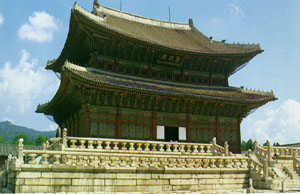
▲
Gunjeogjeon (Hall)

▲
Gyonghoeru (Pavilion)

▲
Hyangwonjeong
(Pavilion)

▲
Jagyongjeon (Pavilion)
|
 
|
In 1394, when Seoul was established
as the capital of the Joseon Dynasty, King Taejo had
the Gyongbokgung
Palace constructed
as the main palace.
Surrounded by Mt. Namsan, In-
wang,
and Mt. Bukak, the site of the Palace was regarded the
most auspicious according to the then geomantic philosophy.
It had 390 halls at the time of the first completion,
and other structures were added later, until all the
palace buildings were burnt down by invading forces,
during the Korean-Japanese War (1592- 1599). The
Prince Regent Daewon-gun, father of King Gojong, restored
the Palace to its current state in the 19th century.
The Gyonghoeru, the venue for banquets
during the Joseon Dynasty, stands on an artificial pond
of square shape, making its vicinity look like a fairyland.
North of it is the Hyangwon pavilion in the middle of
another artificial pond covered with white and yellow
lotus blossoms. It was constructed in 1867 during
the reign of King Gojong at the time of the building
of the Gunchon hall. The pavilion is connected to the
outer area by the Chihyang bridge.
A promenade through the palace also shows
you the Amisan and the Chimneys with the Ten Symbols
of Longevity in the backyard of the Gyotae hall and
the Jagyong hall, respectively, both of which are decorated
with beautiful patterns. The symbolical or mythical
objects like the Ten Symbols of Longevity and the unicorn
and unicorn-lion tell much about things that the Korean
forefathers considered important for the prosperity
of the country and the dynasty.
|